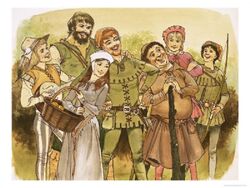| The Merry Men | |
|---|---|
 | |
|
First Appearance |
Unknown |
|
Created by |
English Folklore |
Origin[]
The Merry Men are the group of outlaws who follow Robin Hood in English literature and folklore. The band appears in the earliest ballads about Robin Hood and remain popular in modern adaptations.
The early ballads give specific names to only three companions: Little John, Much the Miller's Son, and Will Scarlet. Joining them are between 20 and "seven score" outlawed yeomen. The most prominent of the Merry Men is Robin's second-in-command, Little John. He appears in the earliest ballads, and is mentioned in even earlier sources, such as Andrew of Wyntoun's Orygynale Chronicle of around 1420 and Walter Bower's expansion of the Scotichronicon, completed around 1440. Later ballads name additional Merry Men, some of whom appear in only one or two ballads, while others, like the minstrel Alan-a-Dale and the jovial Friar Tuck, became fully attached to the legend. Several of the Robin Hood ballads tell the story of how individual Merry Men join the group; this is frequently accomplished by defeating Robin in a duel.
The phrase "merry man" was originally a generic term for any follower or companion of an outlaw, knight, or similar leader. Robin's band are called "mery men" in the oldest known Robin Hood ballad, "Robin Hood and the Monk", which survives in a manuscript completed around 1450.
Named Merry Men[]
- Little John, Robin's lieutenant. Later stories depict him as a huge man who joins the band after fighting Robin with quarterstaves over a river.
- Much the Miller's Son. A grown man and a seasoned fighter in the early ballads, later stories depict him as one of the youngest of the Merry Men. Sometimes referred to a Midge the Miller's Son, which has caused some modern interpretations to make the character a female dressed in mens clothing.
- Will Scarlet, another very early companion, appearing in ballads like "A Gest of Robyn Hode". In "Robin Hood and the Newly Revived," he is a skilled swordsman and Robin's nephew.
- Arthur a Bland, who appears in only one ballad, "Robin Hood and the Tanner". He is an accused poacher who bests Robin in a fight and joins the band.
- David of Doncaster, who appears in only "Robin Hood and the Golden Arrow". He warns Robin against going to the Sheriff of Nottingham's archery contest, because it is a trap. In his novel The Merry Adventures of Robin Hood, Howard Pyle identifies David with the anonymous wrestler of "A Gest of Robyn Hode".
- Will Stutely appears in two ballads, "Robin Hood and Little John" and "Robin Hood Rescuing Will Stutely". In the former, he gives Little John his outlaw name; in the latter, he must be rescued after he is caught spying by the Sheriff of Nottingham. He is occasionally confused with Will Scarlet.
- Friar Tuck, the resident clergyman of the band. Tuck developed separately from the Robin Hood tradition; similar characters appear in 15th- and 16th-century plays, and an early 15th-century outlaw used the alias Friar Tuck. A fighting friar appears in the ballad "Robin Hood and the Curtal Friar", though he is not named. Robin and the friar engage in a battle of wits, which at one point involves the holy man carrying the outlaw across a river, only to toss him in. In the end, the friar joins the Merry Men. Later stories portray Tuck as more ale-loving and jovial than belligerent.
- Alan-a-Dale, a roving minstrel. He appears in the later ballad "Robin Hood and Allen a Dale", in which Robin helps him rescue his sweetheart, who is being forced into marriage with another man. Despite his relatively late appearance, he became a popular character in later versions.
- Maid Marian, Robin Hood's romantic interest. Marian developed separately from the Robin Hood tradition; the medieval French play Jeu de Robin et Marion tells the story of the shepherdess Marian and the knight Robin, and is unrelated to Robin Hood. The medieval archetype of Marian became associated with English and Scottish May Day festivities, and was eventually associated with Robin Hood. She is the protagonist of the ballad "Robin Hood and Maid Marian" and is mentioned in "Robin Hood and Queen Katherine" and "Robin Hood's Golden Prize"; in "Maid Marian" she joins the Merry Men by fighting Robin to a draw while both are in disguise. In some Victorian literature, she takes a more passive role as a noblewoman and Robin's desired, but this all but ended in the 20th century, as Marian resumed her role as a crossdressing tomboy and a capable fighter.
- Gilbert with the White Hand, a much less prominent member.
- Richard at the Lee is sometimes considered to be a member of the Merry Men.
Non-Contemporary Additions[]
- Golden Archer aka Ned. A young boy added to the Merry Men by Holyoke Comics. He has never been incorporated into the overall mythos, however.